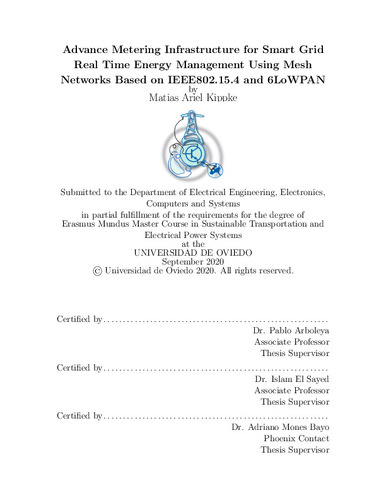Advance Metering Infrastructure for Smart Grid Real Time Energy Management Using Mesh Networks Based on IEEE802.15.4 and 6LoWPAN
Autor(es) y otros:
Palabra(s) clave:
Advance Metering Infrastructure
Smart Grids
6LoWPAN
IEEE 802.15.6
Mesh Networks
Real-Time Energy Management
Fecha de publicación:
Editorial:
Universidad de Oviedo
Serie:
Máster Universitario Erasmus Mundus en Transporte Sostenible y Sistemas Eléctricos de Potencia
Descripción física:
Resumen:
This thesis main goal is to propose an innovative method for smart meters infrastructure for real-time data acquisition, focusing on smart grids application. The initial target was to measure energy readers performances, but later it could be demonstrated that the same communication interface is capable of interconnecting any kind of sensors with a Serial Peripheral Interface, focusing on the integration of IoT devices into a common network. The development involves the comparison between different products available in the market, as well as comparing and selecting a proper communication protocol for the required task, taking into consideration the required bandwidth and power consumption constraints. Simulations have been undertaken using Cooja simulator and coding has been done in C language using Contiki-NG development suite. Final deployment is done based on a mesh-topology network based on IEEE 802.15.4 standard with IPv6 over Low-Power, Lossy Networks IETF 6LoWPAN network structure. A series of test with two smart meters acting as UDP-clients, one data collector device acting as the network gateway and one device as a sniffer is shown, demonstrating the feasibility of the proposed network interface. Future work approach is also presented, where Blockchain applications and peer-to-peer energy trading are considered as the next steps towards full integration with smart cities emerging infrastructures.
This thesis main goal is to propose an innovative method for smart meters infrastructure for real-time data acquisition, focusing on smart grids application. The initial target was to measure energy readers performances, but later it could be demonstrated that the same communication interface is capable of interconnecting any kind of sensors with a Serial Peripheral Interface, focusing on the integration of IoT devices into a common network. The development involves the comparison between different products available in the market, as well as comparing and selecting a proper communication protocol for the required task, taking into consideration the required bandwidth and power consumption constraints. Simulations have been undertaken using Cooja simulator and coding has been done in C language using Contiki-NG development suite. Final deployment is done based on a mesh-topology network based on IEEE 802.15.4 standard with IPv6 over Low-Power, Lossy Networks IETF 6LoWPAN network structure. A series of test with two smart meters acting as UDP-clients, one data collector device acting as the network gateway and one device as a sniffer is shown, demonstrating the feasibility of the proposed network interface. Future work approach is also presented, where Blockchain applications and peer-to-peer energy trading are considered as the next steps towards full integration with smart cities emerging infrastructures.
Patrocinado por:
Phoenix Contact GmbH and Phoenix Contact E-Mobility
Colecciones
- Trabajos Fin de Máster [5292]
Ficheros en el ítem





